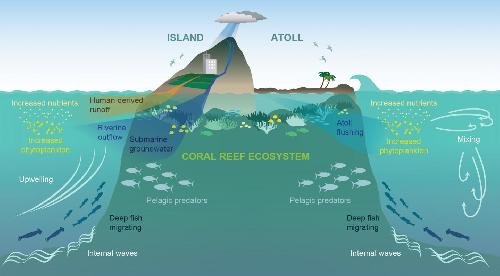Coral reef islands and atolls in the Pacific are predominantly surrounded by vast areas of ocean that have very low nutrient levels and low ecological production. However, the ecosystems near these islands and atolls are often extremely productive and support an enhanced nearshore food-web, leading to an abundance of species and increased local fisheries. An international team of scientists from the National Oceanic and Atmospheric Administration (NOAA), University of Hawaii - Manoa (UHM), National Geographic Society, Scripps Institution of Oceanography, and Bangor University published a study in Nature Communications today which provides the first basin-scale investigation of this paradoxical increase in productivity near coral reef islands and atolls - referred to as the 'Island Mass Effect'
"Surprisingly, scientists have historically known very little with respect to the prevalence, geographic variability, and drivers of this ecologically important phenomenon," said Dr. Jamison Gove, lead author of the study and research oceanographer at the Ecosystems and Oceanography Program of NOAA's Pacific Islands Fisheries Science Center (PIFSC).
Phytoplankton - the microscopic plants that live in sunlit seawater - form the base of the marine ecosystems, and dictate the distribution and production of fisheries in the Pacific and across the globe. Jamison Gove and colleagues studied 35 coral reef islands and atolls, using satellite imagery and ship-based surveys to assess the extent of the Island Mass Effect across the Pacific. Their analysis showed that localized increases in nearshore phytoplankton biomass are a near-ubiquitous feature among locations surveyed, creating biological 'hotspots' across the Pacific.
 This is a schematic showing factors involved in the Island Mass Effect. Credit: Copyright: Gove, et al., 2016
This is a schematic showing factors involved in the Island Mass Effect. Credit: Copyright: Gove, et al., 2016
"Important services that ecosystems provide to human populations, such as fisheries production, can be intrinsically linked to nearshore phytoplankton enhancement associated with the Island Mass Effect," said Dr. Margaret McManus, co-author of the study and oceanography professor at the UHM School of Ocean and Earth Science and Technology (SOEST).
The researchers further discovered that the strength of the Island Mass Effect varied between ecosystems, and that island type, sea-floor slope, reef area, and human habitation are the primary drivers of phytoplankton enhancement differences. Overall, the scientists found that the Island Mass Effect enhances phytoplankton biomass up to 86% over offshore ocean conditions, providing increased food resources for higher trophic groups such as tuna and dolphins.
Although increased phytoplankton is often beneficial for these ecosystems, it can also lead to toxic algal blooms, increased fleshy (non-reef building) algal growth, and other negative impacts when associated with human activities. The ability to discern human- versus natural-driven changes in phytoplankton biomass is of great scientific interest and has important resource management implications. "That humans can artificially elevate phytoplankton biomass - around entire islands - provides important context for the scale at which human activities on land can impact nearshore marine ecosystems." said Gove. "The goal now is to better characterize human activities and their respective influence on nearshore phytoplankton production so that we can develop effective strategies that mitigate future impacts"
source: University of Hawaii at Manoa